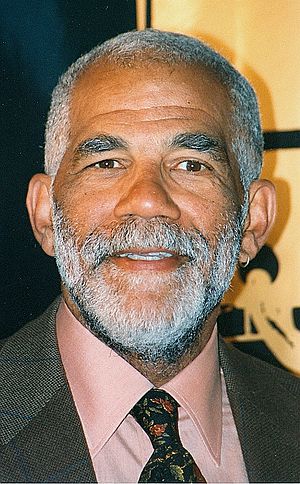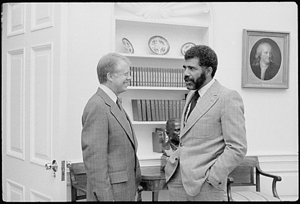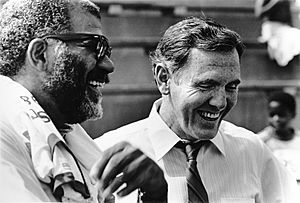Ed Bradley facts for kids
Quick facts for kids
Ed Bradley
|
|
|---|---|

Bradley in 2001
|
|
| Born |
Edward Rudolph Bradley, Jr.
June 22, 1941 Philadelphia, Pennsylvania, U.S.
|
| Died | November 9, 2006 (aged 65) New York City, U.S.
|
| Education | Cheyney University of Pennsylvania (BS) |
| Occupation | Journalist |
| Years active | 1967–2006 |
| Employer | CBS News |
| Television | |
| Spouse(s) |
|
| Awards | Full list |
Edward Rudolph Bradley Jr. (born June 22, 1941 – died November 9, 2006) was a famous American journalist and news anchor. He was best known for his amazing reports on the TV show 60 Minutes and for CBS News. He won many awards for his work, including Peabody and Emmy awards.
Contents
Early Life and Education
Ed Bradley was born in Philadelphia, Pennsylvania, on June 22, 1941. His parents separated when he was young. He grew up in a household that didn't have much money. His mother, Gladys Gaston Bradley, raised him. He spent his summers with his father in Detroit.
Ed went to high school at Mount Saint Charles Academy in Rhode Island. He also attended Saint Thomas More Catholic Boys School in Philadelphia. He graduated from high school in 1959. In 1964, he earned a degree in education from Cheyney State College. While at Cheyney State, he played football for the school team.
Career as a Journalist
Starting Out (1964–1971)
Ed Bradley first worked as a math teacher in Philadelphia in 1964. At the same time, he also worked as a disc jockey at a radio station called WDAS. While working there, he reported on the 1964 Philadelphia race riot. He even interviewed the famous civil rights leader Martin Luther King Jr..
These experiences made him want to be a journalist. He later said he felt it was what he was meant to do. In 1967, Ed moved to New York City to work as a reporter for WCBS radio. At first, he was mostly given stories about African American communities. After talking to his editor, he started getting a wider variety of assignments. He left WCBS in 1971.
Reporting from Around the World (1971–1981)
In 1971, Ed Bradley moved to Paris, France. He spoke French well and was hired by CBS News as a freelance reporter. In 1972, he moved to Saigon to report on the Vietnam War and the Cambodian Civil War. He also covered the Paris Peace Accords, which were peace talks.
While reporting in Cambodia, Ed was hurt by a mortar explosion. After he got better, he went back to Asia to keep reporting on the wars. He was one of the last American journalists to leave in 1975 when the Fall of Saigon happened. He won important awards, like the Alfred I. duPont and George Polk awards, for his brave reporting.

In 1976, Ed was assigned to cover Jimmy Carter's presidential campaign. After Carter won, Ed became the first African American White House correspondent for CBS News. He held this job from 1976 to 1978. He didn't really like being tied to the president's every move.
Also in 1976, he started anchoring the Sunday night news for the CBS Evening News. He did this until 1981. From 1978 to 1981, he was also a main reporter for the documentary show CBS Reports.
In 1979, Ed won his first of many News and Documentary Emmy Awards for his documentary "The Boat People." This report was about Vietnamese refugees escaping their country by boat. He even waded into the water to help rescue some of them. This report also won him an Edward Murrow Award. That same year, his documentary "Blacks in America: With All Deliberate Speed?" aired. It looked at segregation in the United States and how things had changed for African Americans since Brown v. Board of Education. This program also won awards.
Joining 60 Minutes (1981–2006)

In 1981, Ed Bradley joined the famous news show 60 Minutes. The show's producer, Don Hewitt, thought Ed's calm and cool reporting style was perfect for the program. In his first ten years on 60 Minutes, Ed reported on many important stories.
In 1986, Ed interviewed singer Liza Minnelli. During the interview, he mentioned he was interested in wearing an earring. Liza Minnelli gave him a diamond earring after the interview. Ed then started wearing it on air! He was the first male reporter to regularly wear an earring on TV. This was a big deal at the time and showed his unique style. Ed often turned down offers to anchor the CBS Evening News because he loved working on 60 Minutes so much.
In the 1990s, Ed reported on many different topics. These included forced labor camps in China, Russian military bases, and the effects of nuclear weapons testing in Kazakhstan. He also interviewed many famous people, like Muhammad Ali and Mike Tyson. He won many awards during this time, including Emmys and a Peabody Award. In 1995, he won the top Robert F. Kennedy Journalism Award.
From 2000 until his death in 2006, Ed continued to cover important issues. He reported on the AIDS epidemic in Africa. He also interviewed people like Bob Dylan and Neil Armstrong. He even did the only TV interview with Timothy McVeigh.
Ed Bradley reported on about 500 stories for 60 Minutes during his 25 years there. This was more than any other reporter during that time. In 2005, he received a Lifetime Achievement Award from the National Association of Black Journalists.
Illness and Death
In his later years, Ed Bradley was diagnosed with lymphocytic leukemia, a type of cancer. He kept his illness a secret from many people, even his co-workers. His health quickly got worse after he got an infection. But Ed kept working, saying he wanted to die "with (his) boots on." He reported 20 stories in his last year on 60 Minutes. He passed away at Mount Sinai Hospital in Manhattan on November 9, 2006, when he was 65 years old.
Funeral and Memorial
More than 2,000 people attended Ed Bradley's funeral service at Riverside Church in New York. Many famous people were there, including musicians Jimmy Buffett and Wynton Marsalis, journalists like Walter Cronkite, and former U.S. president Bill Clinton. In April 2007, Ed was honored with a special jazz funeral procession at the New Orleans Jazz & Heritage Festival.
Legacy
Impact of His Journalism
Ed Bradley's reporting often focused on fairness and justice. His reports on the AIDS epidemic in Africa helped convince drug companies to donate and lower prices for medicines to treat the disease. His stories about mental hospitals in the U.S. led to government investigations. His reporting on the Duke lacrosse team helped make sure the accused students had a fair trial.
Ed Bradley was a big inspiration for Black Americans. He showed that hard work and dedication could lead to great success.
His Unique Style
Ed Bradley was known for his calm and cool style on TV. His colleagues often described him as "cool." He was very good at interviewing people, making them feel comfortable enough to share information.
He was also known for his unique fashion sense. He often wore interesting patterns, had a short beard, and, of course, wore an earring in his left ear. He started wearing the earring in the 1980s when it was very unusual for men on TV to do so. Many people believe his choice inspired others to wear earrings too.
Helping Others and Honors
In 1994, Ed Bradley and the Radio Television News Directors Association Foundation started a scholarship program in his name. This scholarship gives $10,000 each year to journalists of color. In 2007, he was added to the Broadcast Pioneers Hall of Fame in Philadelphia.
In 2012, faculty at New York University named him one of the "100 Outstanding American Journalists in the last 100 years." In 2015, a street in Philadelphia, City Avenue, was renamed "Ed Bradley Way." A mural of Ed was finished in the city in 2018, and a historical marker was put up in 2021 to honor him.
Personal Life
Ed Bradley loved jazz music. He even hosted a show called Jazz at Lincoln Center on National Public Radio. He sometimes performed with musicians like Jimmy Buffett and the Neville Brothers. The Neville Brothers even called him "the fifth Neville brother."
He also loved being outdoors. In his free time, he often went hiking or skiing.
Ed Bradley was married three times. His wives were Diane Jefferson, Priscilla Coolidge, and Patricia Blanchet. He divided his time between his homes in New York and Colorado.
Images for kids
See also
 In Spanish: Ed Bradley para niños
In Spanish: Ed Bradley para niños
- History of African Americans in Philadelphia
- List of Cheyney University of Pennsylvania alumni
- List of people from Philadelphia
- The Interviews: An Oral History of Television
- National Association of Black Journalists Hall of Fame




